Everything you need to know about the MLB’s extra-inning rule that takes place to determine the outcome of a game.

In recent years, Major League Baseball (MLB) has implemented a new rule known as the “Extra Innings Rule” to address the length of games that go beyond the regulation nine innings and to increase the level of excitement during those games. As a result of the fact that it makes a number of substantial alterations to the traditional nature of the game, this rule has sparked debate among fans, players, and analysts. In this discussion, we will investigate the Extra Innings Rule of Major League Baseball, including its goals, how it was implemented, and the effect it has had on the sport.
The primary objective of the Extra Innings Rule is to reduce the amount of time that is spent on games that continue beyond the ninth inning. This will result in a higher level of excitement for all parties involved, including the players and the fans. Before the implementation of this rule, extra-inning games had the potential to continue for a number of additional innings, which led to lengthy competitions that frequently continued into the early hours of the morning. Not only did this have an impact on the stamina and performance of the players, but it also made things difficult for fans who attended or watched the games in person.
In accordance with the Extra Innings Rule, the tenth inning will begin with a runner from each team starting at second base. The player who made the final out in the previous inning is the one who usually serves as the runner, but teams do have some leeway in choosing who will run in each inning. The presence of a runner in the scoring position at the start of the inning raises the probability that runs will be scored, which immediately adds to the tension and excitement of the game.
Major League Baseball hopes that the implementation of this rule will result in more action and opportunities for scoring during extra-inning games, as well as encourage games to be decided more quickly. When there is a runner on second base when the inning begins, the opposing team is forced to adjust their game plan and will typically focus on small-ball strategies such as bunting and sacrifices in order to move the runner over to the third base and potentially score the winning run. A new dynamic has been introduced into the game as a result of this shift in strategy, which favors teams that possess powerful situational hitters and pitchers who are skilled at preventing runs in high-pressure situations.
MLB’s extra-innings rule has drawn criticism
The Extra Innings Rule has drawn criticism from those who believe that it fundamentally alters the essence of baseball by deviating from the traditionally accepted rules. They argue that by doing so, an artificial element is introduced, which detracts from the sport’s overall authenticity. Traditionalists hold the view that the outcome of games that go into extra innings should be decided solely by the skills and capabilities of the players, rather than by an imposed rule that changes the game’s dynamics.

Extra-inning games, on the other hand, are said to have a higher level of excitement and urgency as a result of the rule, which is an argument made by supporters of the rule. The presence of a runner on second base raises the odds of scoring, which results in an increased number of tie scores, dramatic finishes, and strategic decisions. Additionally, the rule addresses concerns about the length of games, preventing the physical and mental toll that marathon games can have on players while also allowing fans to enjoy the entirety of the game without feeling fatigued or experiencing conflicts with their schedules.
Since it was introduced, the Extra Innings Rule has undeniably had an impact on both the results of extra-inning games and fans’ perceptions of those games. According to the data, games played under the new rule tend to end more quickly, and there is a greater likelihood that the outcome will be decided by the tenth inning or shortly afterward. This has not only had an effect on the length of the games, but it has also placed a greater emphasis on the decisions made by managers, the strategies used by pitchers, and the ability of players to perform effectively under pressure.
Also Read: Will Matt McLain play in MLB this season? Cincinnati Reds drop major update on prospect
In summary, the MLB Extra Innings Rule has stimulated a substantial amount of conversation and debate within the baseball community. While it does change the traditional nature of the game, it also brings in a new dynamic that significantly amps up the excitement and forces players to make more strategic decisions.
One’s point of view and degree of emotional investment in baseball’s time-honored customs have a significant impact on whether one view this change as a positive or negative development. In spite of this, the rule has undeniably brought about revolutionary changes to games that go into extra innings, leaving an indelible mark on the sport even as it continues to develop and adjust to the shifting norms of society.
Read More:
- “I would love to have on my team for sure”- Francisco Lindor isn’t shutting down the idea of Shohei Ohtani on New York Mets
- “Nothing I can do about it”- Fernando Tatis Jr. isn’t fazed about critics ahead of MLB return
- “Lost all credibility. Unbelievable. The league, media, and voters hate on Machado”: MLB Fans are furious to see Manny Machado miss out on being the finalist for the Golden Glove Award
Follow our dedicated page for MLB for instant news and updates.

